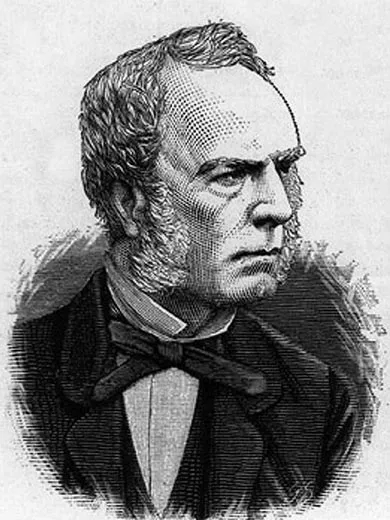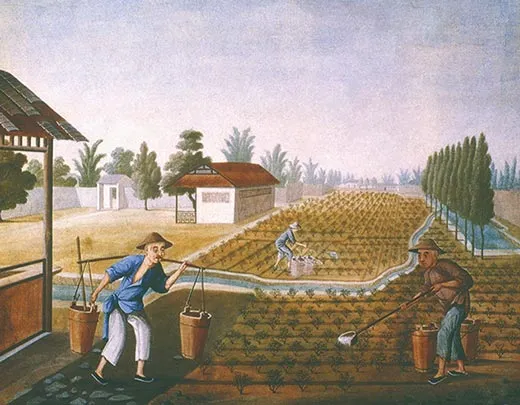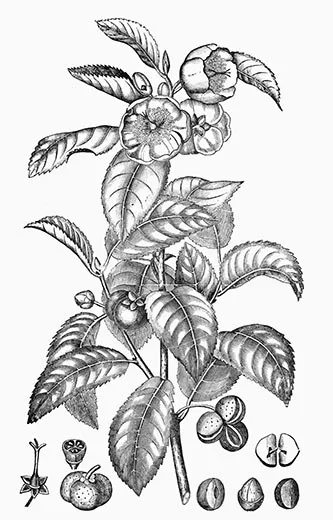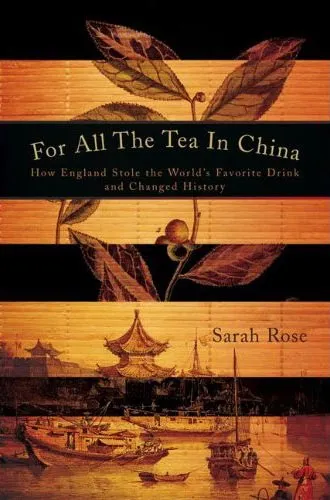The Great British Tea Heist
Botanist Robert Fortune traveled to China and stole trade secrets of the tea industry, discovering a fraud in the process
/https://tf-cmsv2-smithsonianmag-media.s3.amazonaws.com/filer/Chinese-tea-plantation-631.jpg)
In 1848, the British East India Company sent Robert Fortune on a trip to China's interior, an area forbidden to foreigners. Fortune's mission was to steal the secrets of tea horticulture and manufacturing. The Scotsman donned a disguise and headed into the Wu Si Shan hills in a bold act of corporate espionage.
This is an excerpt from For All the Tea in China: How England Stole the World’s Favorite Drink and Changed History by Sarah Rose.
With [his servant] Wang walking five paces ahead to announce his arrival, Robert Fortune, dressed in his mandarin garb, entered the gates of a green tea factory. Wang began to supplicate frantically. Would the master of the factory allow an inspection from a visitor, an honored and wise official who had traveled from a far province to see how such glorious tea was made?
The factory superintendent nodded politely and led them into a large building with peeling gray stucco walls. Beyond it lay courtyards, open work spaces, and storerooms. It was warm and dry, full of workers manufacturing the last of the season’s crop, and the woody smell of green tea hung in the air. This factory was a place of established ceremony, where tea was prepared for export through the large tea distributors in Canton and the burgeoning tea trade in Shanghai.
Although the concept of tea is simple—dry leaf infused in hot water—the manufacture of it is not intuitive at all. Tea is a highly processed product. At the time of Fortune’s visit the recipe for tea had remained unchanged for two thousand years, and Europe had been addicted to it for at least two hundred of them. But few in Britain’s dominions had any firsthand or even secondhand information about the production of tea before it went into the pot. Fortune’s horticultural contemporaries in London and the directors of the East India Company all believed that tea would yield its secrets if it were held up to the clear light and scrutiny of Western science.
Among Fortune’s tasks in China, and certainly as critical as providing Indian tea gardens with quality nursery stock, was to learn the procedure for manufacturing tea. From the picking to the brewing there was a great deal of factory work involved: drying, firing, rolling, and, for black tea, fermenting. Fortune had explicit instructions from the East India Company to discover everything he could: “Besides the collection of tea plants and seeds from the best localities for transmission to India, it will be your duty to avail yourself of every opportunity of acquiring information as to the cultivation of the tea plant and the manufacture of tea as practised by the Chinese and on all other points with which it may be desirable that those entrusted with the superintendence of the tea nurseries in India should be made acquainted.”
But the recipe for the tea was a closely guarded state secret.
In the entry to the tea factory, hanging on the wall, were inspiring calligraphic words of praise, a selection from Lu Yu’s great work on tea, the classic Cha Ching.
The best quality tea must have
The creases like the leather boots of Tartar horsemen,
Curl like the dewlap of a mighty bullock,
Unfold like a mist rising out of a ravine,
Gleam like a lake touched by a zephyr,
And be wet and soft like
Earth newly swept by rain.
Proceeding into the otherwise empty courtyard, Fortune found fresh tea set to dry on large woven rattan plates, each the size of a kitchen table. The sun beat down on the containers, “cooking” the tea. No one walked past; no one touched or moved the delicate tea leaves as they dried. Fortune learned that for green tea the leaves were left exposed to the sun for one to two hours.
The sun-baked leaves were then taken to a furnace room and tossed into an enormous pan—what amounted to a very large iron wok. Men stood working before a row of coal furnaces, tossing the contents of their pans in an open hearth. The crisp leaves were vigorously stirred, kept constantly in motion, and became moist as the fierce heat drew their sap toward the surface. Stir-frying the leaves in this way breaks down their cell walls, just as vegetables soften over high heat.
The cooked leaves were then emptied onto a table where four or five workers moved piles of them back and forth over bamboo rollers. They were rolled continuously to bring their essential oils to the surface and then wrung out, their green juice pooling on the tables. “I cannot give a better idea of this operation than comparing it to a baker working and rolling his dough,” Fortune recalled.
Tightly curled by this stage, the tea leaves were not even a quarter the size they had been when picked. A tea picker plucks perhaps a pound a day, and the leaves are constantly reduced through processing so that the fruits of a day’s labor, which filled a basket carried on a tea picker’s back, becomes a mere handful of leaves—the makings of a few ounces or a few cups of brewed tea. After rolling, the tea was sent back to the drying pans for a second round of firing, losing even more volume at every contact with the hot sides of the iron wok.
With leaves plucked, dried, cooked, rolled, and cooked again, all that was left to do was sort through the processed tea. Workers sat at a long table separating the choicest, most tightly wound leaves—which would be used in the teas of the highest quality, the flowery pekoes—from the lesser-quality congou and from the dust, the lowest quality of all.
The quality of tea is partly determined by how much of the stem and rougher lower leaves are included in the blend. The highest-quality teas, which in China might have names like Dragon Well, or in India FTGFOP1 (Finest Tippy Golden Flowery Orange Pekoe First Grade), are made from the topmost two leaves and the bud at the end of each tea branch. The top shoots taste delicate and mild, and are only slightly astringent; therefore the most pleasant and refreshing.
The distinctive quality of tea comes from essential oils that leach flavor and caffeine into a cup of hot water. These chemical compounds are not necessary for the primary survival of the tea plant’s cells; they are what is known as secondary compounds. Secondary chemicals help plants in many different respects, such as defending them against pests, infections, and fungus, and aiding them in their fight for survival and reproduction. Tea, like other green plants, has several defense systems against predators: Caffeine, for instance, is a natural insecticide. Almost all of tea’s thick waxy leaves, apart from the topmost shoots, are bitter and leathery and difficult to bite through. Tea also has hard, fibrous stalks to discourage animal incursion. Clumsy pickers can compromise the quality of tea by including a leaf farther down the stem and even some of the stem itself; this will make for a harsher, more tannic brew, and in China it will be qualified by names suggesting crudeness, such as dust.
The workers sat at long low tables to pick through the leaves and sort out any pieces of stem. They also looked for any insects that might have tainted the batch, as well as small stones and pieces of grit from the factory floor. Even with a measure of quality control, tea was not a clean product in any sense, which is one of the reasons that Chinese tea drinkers traditionally discard the first cup from any pot. “The first cup is for your enemies,” the saying goes among connoisseurs.
Culinary historians know nothing about who first put leaf to water. But where human knowledge has failed, human imagination has inserted itself. Many Chinese believe that tea was discovered by the mythical emperor Shennong, inventor of Chinese medicine and of farming. The story goes that one day the emperor was reclining in the leafy shade of a camellia bush when a shiny leaf dropped into his cup of boiled water. Ripples of light green liquor soon began to emerge from the thin, feathery leaf. Shennong was familiar with the healing properties of plants and could identify as many as seventy poisonous plants in a daylong hike. Convinced that the camellia tisane was not dangerous, he took a sip of it and found that it tasted refreshing: aromatic, slightly bitter, stimulating, and restorative.
Ascribing the discovery of tea to a revered former leader is a characteristically Confucian gesture—it puts power in the hands of the ancestors and links the present day to the mythic past. But Buddhists in China have their own creation story for tea, featuring Siddhartha Gautama (Gautama Buddha). As a traveling ascetic, legend tells us, the young monk Siddhartha was wandering on a mountain, perfecting his practice, and praying without ceasing. The weary supplicant sat down by a tree to meditate, to contemplate the One and the many faces of redemption, and promptly fell asleep. When he awoke, he was furious at his own physical weakness; his body had betrayed him, his eyes were leaden, and drowsiness had interfered with his quest for Nirvana. In a fit of rage and determined that nothing would again impede his path to Truth and Enlightenment, he ripped out his eyelashes and cast them to the wind, and in all the places they fell sprang forth a fragrant and flowering bush: the tea plant. Indeed, the fine, silvery down on the undersides of the highest-quality tea leaves resembles delicate eyelashes. Buddha, all great and compassionate, bequeathed to his followers a draft that would keep them aware and awake, invigorated and focused, an intoxicant in the service of devotion. Before Fortune, botanists had failed in their attempts to decode the formula for tea. His first collecting trip to China in 1843, for the Royal Horticultural Society, had taken him to the fringes of tea territory as part of his general collecting mandate. At that time he had made an important discovery: Green tea and black tea came from the same plant. The Linnaean Society had hitherto declared unequivocally that green and black tea were siblings or cousins, closely related but under no circumstances twins. The great [Carolus] Linnaeus, a century before, working from dried samples brought back from China by earlier explorers, concluded that the two were distinct taxa: Thea viridis and Thea bohea. Thea viridis, or green tea, was said to have alternating brown branches and alternating leaves: bright green ovals that were short-stalked, convex, serrated, shiny on both sides, and downy beneath, and with a corolla, or flower, of five to nine unequally sized white petals. Thea bohea, black tea, was described as looking nearly the same—only smaller and somewhat darker. On his first trip Fortune expected to find identifiable black tea plants in gardens known to produce black tea. Yet he discovered that the tea plants there looked just like the green tea plants in the green tea gardens. Over the course of that first three-year visit, when procuring several tea samples and thoroughly investigating them, he had concluded that any difference between green tea and black was the result of processing alone. His botanical colleagues were slow to agree, requiring more proof. Black tea is fermented; green tea is not. To make black tea, the leaves are allowed to sit in the sun for an entire day to oxidize and wilt—essentially to spoil a little. After the first twelve hours of stewing, black tea is turned, the liquor is stirred around, and the mixture is left to cure for another twelve hours. This longer curing process develops black tea’s tannins, its strong bitter flavor, and its dark color. Although it is called fermenting, the process of making black tea is technically misnamed. Nothing ferments in a chemical sense; there are no microorganisms breaking down sugars into alcohol and gas. Black tea is, rather, cured or ripened. But the language of wine colors the language of all beverages, and so the label of “fermentation” has stuck to black tea. (Indeed, if tea does ferment and fungus grows, a carcinogenic substance is produced.) Given that to that point no European botanist had seen tea growing or evaluated it in its living state, the Linnaean Society’s confusion on the subject is understandable. Fortune’s documentary evidence ultimately changed tea’s Linnaean classification. It would soon be known categorically as Thea sinensis, literally tea from China. (Later still it would be reclassified as part of the Camellia family, Camellia sinensis.) As he made his way through the green tea factory, Fortune took note of something both peculiar and more than a little alarming on the hands of the tea manufacturers. It was the kind of observation that, once reported, would be an invaluable boon to the burgeoning Indian tea experiment, with the power to boost the sales of Indian tea over Chinese. While staring at the workers busy in the final stages of processing, he noticed that their fingers were “quite blue.” Among the blenders and tasters of the London auction it was generally assumed that the Chinese engaged in all manner of duplicity, inserting twigs and sawdust into their teas to bulk up the loose leaves. It was said that the Chinese were brewing their own breakfast tea, saving the soggy leaves to dry in the sun, and then reselling the recycled product as fresh tea for the gullible “white devils.” There was no trust in the trade, no faith in the goodwill of the Chinese manufacturers. But the blue substance on the fingers of the Chinese workmen seemed to Fortune a matter of legitimate concern. What could be the source of this? He and others had long suspected that the Chinese were chemically dyeing tea for the benefit of the foreign market. He was now in a position to prove or disprove the charge. He watched each step of the processing carefully, saying nothing, making notes, and occasionally asking Wang to put a question to a manager or worker. At one end of the factory the supervisor stood over a white porcelain mortar. In the bowl was a deep blue powder, made finer and finer with each grind of the pestle. The superintendent was in fact preparing iron ferrocyanide, a substance also known as Prussian blue, a pigment used in paints. When cyanide is ingested, it binds to iron inside cells, interfering with the absorption of certain enzymes and compromising a cell’s ability to produce energy. Cyanide affects the tissues most needed for aerobic respiration, the heart and lungs. In high doses cyanide can bring on seizures, coma, and then cardiac arrest, killing quickly. At lower doses cyanide leads to weakness, giddiness, confusion, and light-headedness. Exposure to even low levels of cyanide over long periods of time can lead to permanent paralysis. Fortunately for the tea drinkers of Britain, Prussian blue is a complex molecule, so it is almost impossible to release the cyanide ion from it and the poison passes harmlessly through the body. Elsewhere in the factory, however, over the charcoal fires where the tea was roasted, Fortune discovered a man cooking a bright yellow powder into a paste. The smell was terrible, like that of rotten eggs. The yellow substance was gypsum, or calcium sulfate dehydrate, a common component of plaster. Gypsum produces hydrogen sulfide gas as it breaks down. While the gas is produced naturally by the body in low doses, in high doses it acts as a broad-spectrum poison, affecting many of the body’s systems simultaneously, particularly the nervous system. At lower concentrations gypsum acts as an irritant; it reddens the eyes, inflames the throat, and causes nausea, shortness of breath, and fluid in the lungs. Consumed over the long term it might produce fatigue, memory loss, headaches, irritability, and dizziness. It can even induce miscarriage in women, and failure to thrive in infants and children. Fortune estimated that more than half a pound of plaster and Prussian blue was included in every hundred pounds of tea being prepared. The average Londoner was believed to consume as much as one pound of tea per year, which meant that Chinese tea was effectively poisoning British consumers. The additives were not included maliciously, however, for the Chinese simply believed that foreigners wanted their green tea to look green. “No wonder the Chinese consider the natives of the West to be a race of barbarians,” Fortune remarked. But why, he asked, were they making green tea so extremely green, since it looked so much better without the addition of poison and since the Chinese themselves would never dream of drinking it colored? “Foreigners seemed to prefer having a mixture of Prussian blue and gypsum with their tea, to make it look uniform and pretty, and as these ingredients were cheap enough, the Chinese [have] no objection to [supplying] them as such teas always fetch . . . a higher price!” Fortune surreptitiously collected some of the poisonous dyes from the factory, bundling them up in his wax-dipped cloth sacks and stowing them away in the generous folds of his mandarin costume. As a scientist he wanted samples to analyze, but most of all he wanted to send additional ones back to England. These substances would be prominently displayed in London’s Great Exhibition of 1851. In the glittering Crystal Palace, Britain displayed to the world all its industrial, scientific, and economic might, including the green tea dyes. This public exhibition marked the moment when tea, the national drink of Britain, came out of the shadows of myth and mystery and into the light of Western science and understanding. Fortune unmasked unwitting Chinese criminality and provided an irrefutable argument for British-manufactured tea. This is an excerpt from For All the Tea in China: How England Stole the World’s Favorite Drink and Changed History by Sarah Rose.



